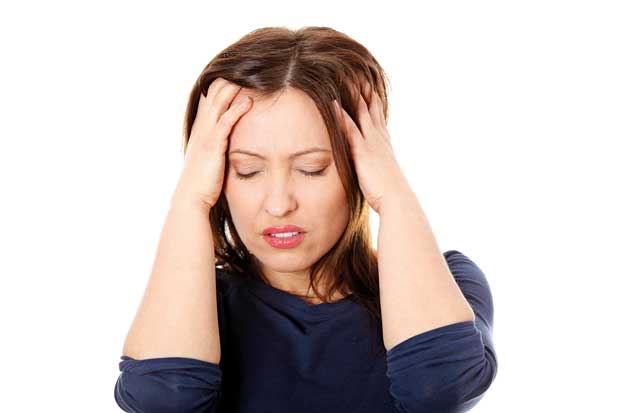21 Jun 2017 - {{hitsCtrl.values.hits}}

 Many people suffer from migraines at a young age but most do not know how to identify them. According to Dr. Arjuna Fernando, a Neurologist at the Colombo North Teaching Hospital, a migraine is a pounding, throbbing headache usually felt on one side of the head. “By definition, a typical migraine may go on for more than half an hour. Some migraines even go on for two to three days. Usually more women suffer from migraines than men. They begin in a person’s teens and continue into their 20s, 30s and 40s. Often, after about the age of 50, the severity of the headache reduces. For women, the onset of a migraine begins during their menstrual cycle and often settles with menopause. Age is not a factor, it’s just that we can’t really diagnose it in very small children because they can’t express it.”
Many people suffer from migraines at a young age but most do not know how to identify them. According to Dr. Arjuna Fernando, a Neurologist at the Colombo North Teaching Hospital, a migraine is a pounding, throbbing headache usually felt on one side of the head. “By definition, a typical migraine may go on for more than half an hour. Some migraines even go on for two to three days. Usually more women suffer from migraines than men. They begin in a person’s teens and continue into their 20s, 30s and 40s. Often, after about the age of 50, the severity of the headache reduces. For women, the onset of a migraine begins during their menstrual cycle and often settles with menopause. Age is not a factor, it’s just that we can’t really diagnose it in very small children because they can’t express it.”
Symptoms
Speaking of the symptoms of a migraine, Dr. Fernando said, “A migraine is usually a unilateral headache. A typical migraine is felt on one side of the head. It mostly occurs in front of the head but can also be felt at the back. Sometimes the pain can localize over the eyes. As many patients feel pain over the eyes, they tend to go to an eye surgeon.”
He further said many patients experienced warning signs before the onset of a migraine. “What is special about migraines is that some patients often get a warning signal that they are getting a headache. Sometimes it is preceded by flashes of light, like sparklers, sometimes they feel dizzy, like the world is spinning around, similar to vertigo. The headache is usually very severe and the patient may feel nauseous. Some will actually start vomiting. Some also show sensitivity to bright light, loud noises and even strong smells.”
Causes
Dr. Fernando said there were many causes for migraines, “To start with, there is a very large genetic bias. 80% of migraines start with a family history. However, there are other general factors which precipitate migraines. The common ones are a lack of sleep, hunger, dehydration, sunlight or very bright light, wet hair after a shower-especially in the case of girls who have a shower in the evening or night.”
He further said there were various types of food and drinks that could precipitate migraines. “This can vary from person to person. Almost every known food item can precipitate migraines. If you realise that a certain type of food or drink brings on a headache, it’s best to avoid it. The most common are alcoholic beverages such as red wine. Most fermented foods such as cheese, curd, yoghurt and achcharu are also responsible. Other foods are chocolate, coffee and oily food. However, one must bear in mind that precipitation from food and drinks are not common in everyone.”
“Exhaustion from extreme exercise such as marathons or cycle rides could also be a cause. Stress is another factor. Certain people who have suffered head trauma may also have migraines. Some migraines can be precipitated due to eye problems or reading difficulties. Some children have difficulty with the coordination of their eyes since the eye muscles do not work harmoniously and do not focus on the same point. These children find it difficult to read as this precipitates headaches. There are those who are near-sighted and who struggle to see the blackboard in school, causing them to get migraines,” he added.
Phases of a migraine
Dr. Fernando further said, “Many people feel a warning signal first, then they develop the headache which is where the pain component comes in. In some people, once the headache is over, they feel exhausted and go to sleep. Quite often once they sleep and awake, the migraine is gone.”
Prevention is better than cure
Dr. Fernando said there was no permanent cure for migraines, so patients were advised to prevent it from worsening. “There’s no complete cure for migraines. When it comes to treatment, prevention is better. Prevention would include eating on time, drinking a sufficient amount of water, avoiding sunlight, drying hair after a shower particularly for girls, having good sleep patterns and avoiding excess alcohol. Any type of alcohol can bring on migraines.”
“Once a person has been diagnosed, the first thing is to take painkillers at the onset. Some people tend to take the painkiller after two days of getting the headache. However, if you take it early, you might be able to avoid the brunt of it. For those who get it because of delayed meals, we recommend that they have meals on time if they notice their hunger is accompanied with migraines. We also advise patients to go to a quiet place and lie down if possible,” he added.
23 Dec 2024 9 hours ago
23 Dec 2024 23 Dec 2024
23 Dec 2024 23 Dec 2024
23 Dec 2024 23 Dec 2024